Fostering Quality, Green Development in the PRC through Public–Private Partnerships and Thematic Financing
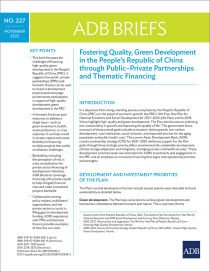



The pandemic has highlighted the importance of technology in managing the crisis. Public-private partnerships, coupled with global cooperation, could help us explore technological solutions beyond the earth.
The world has been upended by the COVID-19 pandemic. To combat the spread of the virus, global cooperation and partnerships are of paramount importance. But we should be looking further afield for solutions, to a place beyond our planet but increasingly within reach of human collaboration.
Space technology is one area where governments and the private sector can join forces to defeat this infectious disease. In fact, public-private partnerships (PPPs) in space technology is nothing new. As early as 1962, the United States encouraged private sector participation in the space sector and its technology and it continues to have the most seasoned and active space program, contributing 58% of the $70.9 billion global government spending on space in 2018.
Most space-related PPPs are focused on sharing risk and innovation with the private sector. The current emphasis is to leverage commercial sector innovation and agility.
For example, under NASA’s Commercial Crew Program, SpaceX launched the Crew Dragon, the first private sector owned, built, tested, and operated American manned spacecraft on its way to the International Space Station. The historic event demonstrates NASA’s continued commitment to invest and engage with private companies through PPPs.
The benefits are obvious. Space sector partnerships provide efficiency gains by tapping into private sector expertise, reduce lifecycle costs by attaining value for money, and allocate risks to the sector best suited to manage it.
For the private sector, it means opportunities for return on investments, potential competitive and market advantage, and additional revenue streams from unique government assets.
Beyond these, partnerships in the space industry deliver two additional advantages. Transfer of technology—both from the government space agency to the private sector (“Spin-Offs”) and vice versa (“Spin-Ins”)—and policy alignments, whether to stimulate a country’s commercial space sector or to reach development goals, such as eliminating the digital divide or furthering global health objectives.
A recent study, covering 437 articles from 1981 to 2017, identified four key space technologies that have applications to global health: remote sensing; Global Navigation Satellite Systems; satellite communications; and human spaceflight.
In practice, PPPs that utilized space technologies have proven effective in responding to the COVID-19 pandemic.
The Republic of Korea has collaborated with the private sector in increasing production and creating applications that optimize and coordinate the distribution of personal protective equipment (PPE) using satellite navigation and communication technologies. Through PPE tracker apps, citizens are provided with accurate information on the availability and location of such equipment, empowering them to make informed decisions, avoid crowds, and prevent panic buying.
In the People’s Republic of China, satellite technologies, such as the local BeiDou Navigation Satellite System, have been crucial assets in tracking patients’ positions (e.g., Wuhan Mini Neighborhood App), monitoring cargo transport (e.g., White Rhino Auto’s self-driving delivery vehicle), and guiding drones for large-scale disinfection missions (Qianxun Spatial Intelligence).
While these innovative space applications are exciting, especially the creative PPPs in response to the COVID-19 outbreak, they are not without challenges.
Developing countries without a workforce with solid numeracy and digital literacy, proper infrastructure, and an enabling regulatory environment, face limited prospects in adopting the opportunities that space technologies present. The pandemic has reinforced the importance of digital readiness for countries to respond effectively and inclusively, as well as maintain societal resilience and business continuity amidst the crisis.
Public-private partnerships, coupled with global cooperation, have the capacity to bring countries one step closer to exploring the final frontie
The nature of space development—high cost, high risk, and long lead-times—also intensify the difficulty of establishing national space programs. PPPs do not eliminate these challenges, rather, they provide an avenue for better risk management by making use of the best qualities offered by each participant.
PPPs and space technology development should always be tailored to the local context. In India, for example, private participation in the space sector remains limited to supplying parts and components for satellites and launch vehicles manufactured by the Indian Space Research Organization. Enabling the private sector to independently innovate and grow remains a challenging prerequisite to fully capitalize on the benefits of PPPs.
Recognizing these limitations, two international organizations exist to support and enhance spacefaring initiatives and cooperation in the region: the Asia-Pacific Regional Space Agency Forum established in 1993 and the Asia-Pacific Space Cooperation Organization founded in 2008.
Both organizations promote cross-sectoral and inter-governmental cooperation and resource sharing in space science, space technology, and space application, as drivers of socio-economic development in Asia and the Pacific.
ADB has also been supportive in implementing effective space technology applications in many projects since the 1990s. Recent space technology ventures include the $50 million financing of the Kacific1 satellite, which will deliver internet connectivity to remote and rural communities in the Asia and Pacific region. Another initiative is the Spatial Data Analysis Explorer (SPADE), an interactive web-based cloud platform that contains various geospatial data which can be used for project preparation, design and monitoring.
Now, more than ever, the space-Earth frontier should no longer be exclusive to a narrow niche of institutions and space-faring countries. Even in normal times, space technologies have offered innovative solutions to connectivity, inclusivity, and resilience challenges, and have supported healthcare delivery in the most extreme situations.
The pandemic has highlighted the importance of these technologies in managing the crisis and putting countries back on track to sustainable development. Public-private partnerships, coupled with global cooperation, have the capacity to accelerate this initiative and bring countries one step closer to exploring the final frontier.

Associate Information and Research Coordinator (PPP), OAS
This blog is reproduced from Asian Development Blog.
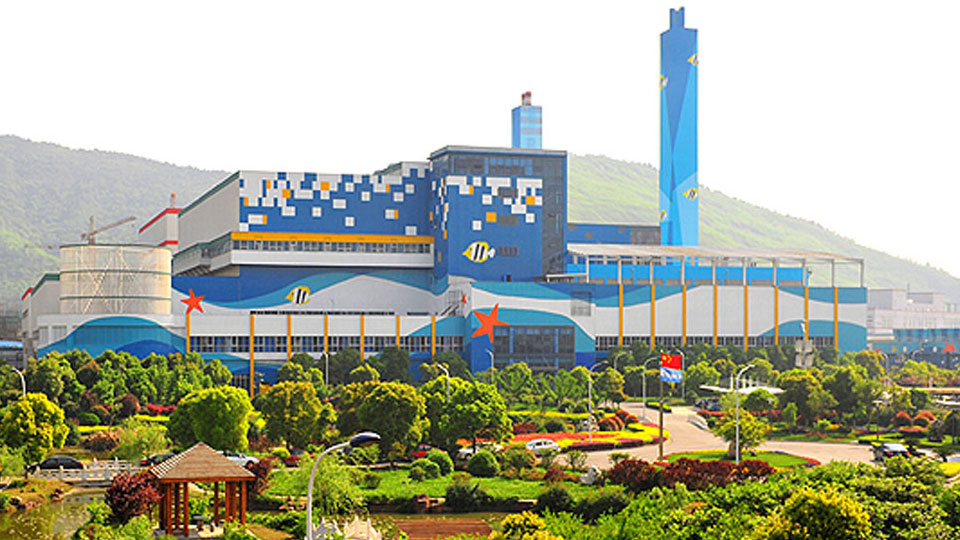
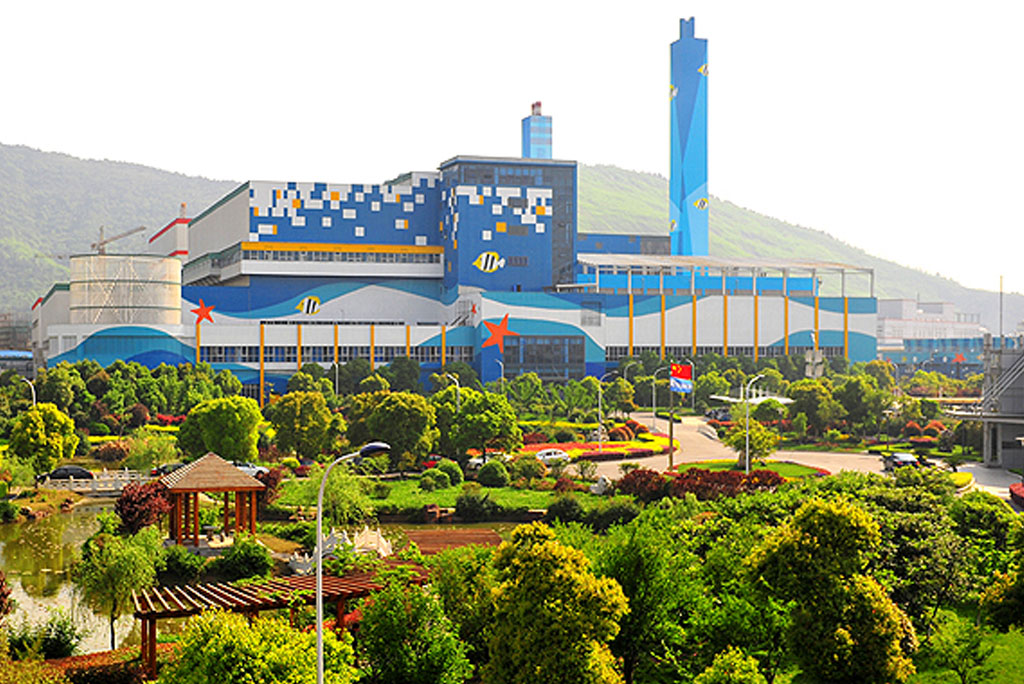
Public-private partnerships can help make clean technologies for turning waste into energy accessible to cities.
Overview
Relevant and practical integrated waste management approaches are crucial for countering public health impacts of uncollected waste and environmental impacts of open dumping and burning. Medium to large cities in the People’s Republic of China (PRC) considers this as a pressing need to help them attain environmental sustainability and improve the quality of life of their citizens.
Turning municipal solid waste into energy through the waste-to-energy process is one of the popular strategies of solving the rise of generated waste. It involves incinerating waste to produce energy in the form of electricity or heat. Unfortunately, lack of access to finance and a gap in technological knowledge made it difficult for cities to adopt this strategy.
Project information
43901-014: China, People’s Republic of: Municipal Waste to Energy Project
Project snapshot
Context
The People’s Republic of China is the world’s largest producer of municipal solid waste, generating about 215 million tons in 2017. This is expected to increase to 500 million tons per year by 2025 as urban population continues to rise.
The ineffective disposal of solid waste poses serious environmental and social challenges in the cities. It contaminates soil and groundwater when dumped in un-engineered landfills. Meanwhile, a number of emission control and leachate treatment facilities in engineered landfills also lack adequate clean technologies and operational know-how. These expose many urban poor, especially those living near landfills, to severe air and water pollution and the threat of infectious diseases.
Incineration is recognized as an effective method for waste treatment since it reduces waste volume by 90% and eliminates methane emissions. Waste-to-energy technologies recover energy from the incineration process to produce electricity and heat. By replacing fossil fuel combustion and avoiding methane, these technologies help avoid greenhouse gas emissions and mitigates climate change.
Development Challenges
The government of the People’s Republic of China enacted laws and regulations between 2004 to 2007 to promote waste management and control environmental pollution and city-level public-private partnership (PPP) based on concession agreement.
Despite the recent policy shift in favor of waste-to-energy and the increased interest of municipal governments in clean technologies, market barriers still limit the expansion of waste-to-energy projects with clean technologies in the country.
One of the key bottlenecks is the lack of access to finance due to the following:
Solution
To reduce the environmental impact of unhygienic waste disposal, ADB in 2009 approved a $100 million long term loan to support, through PPP, the construction and operation of waste-to-energy projects in the People’s Republic of China. The project aimed to:
China Everbright International Limited served as the project sponsor while China Everbright Environmental Energy Limited (CEEEL)—in charge of building, operating, and maintaining waste-to-energy plants based on the concession agreements with the municipal governments —was the borrower.
The project featured an efficient private sector participation model in waste-to-energy projects through PPP for multiple projects in medium-sized municipalities. Located in different cities, these multiple waste-to-energy projects are often too small for banks to finance on a standalone basis. ADB structured a facility to support portfolio subprojects efficiently using a portfolio approach. Under this approach, the ADB loan was provided to a holding company and channeled to the waste-to-energy project companies.
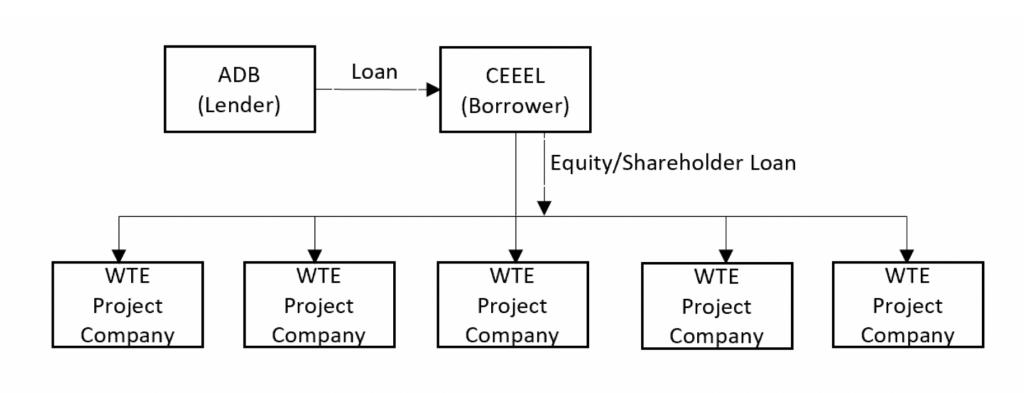
This model encouraged the private sector to invest in waste-to-energy projects with clean technologies. It mobilized available domestic funds, creating better awareness among commercial banks and willingness to finance more waste-to-energy efforts.
A $653,000 technical assistance grant funded by the Clean Energy Fund was also used to support the reporting and environmental management of the waste-to-energy facilities.
Results
The project benefited approximately 18 million city dwellers, 12.5% more than the target. It helped create better living standards in the cities of Jinan, Suzhou, Zhenjiang, Pizhou, and Sanya. By reducing the amount of untreated waste delivered to landfills, the waste-to-energy plants reduced pollutants and improved air quality in the said cities.
Likewise, the project diversified energy sources and reduced greenhouse gas emissions in the People’s Republic of China. In 2014, the project generated 956 gigawatt-hours (GWh) of green electricity and reduced 1.2 million tons of carbon dioxide emissions by eliminating methane and replacing fossil fuels. Since 2011, the project has generated 3,642 GWh of electricity and reduced 4.7 million tons of carbon dioxide emissions.
Waste-to-energy plants received local awards and served as demonstration models for efficient municipal solid waste management. For example, the Jinan plant received the Luban Award–the nation’s highest honor for project quality in 2012–2013, while the Zhenjiang plant received the highest score in the Jiangsu Provincial Assessment.
Moreover, the project has encouraged other cities in the People’s Republic of China to replicate the business model. As of 2014, several local governments such as Fujian, Qinghai, Anhui, Hunan, and Sichuan have been piloting or implementing PPP projects. China Everbright International Limited has set market standards and benchmarks and helped the government plan enabling laws at both the national and municipal levels.
Lessons
The project highlighted the importance of ensuring a robust project design, partnering with the right sponsor, providing technical assistance for capacity building to upgrade operations and skills, and facilitating the transfer of knowledge and technology.
Choosing the right project sponsor is key to ensuring smooth and successful implementation. China Everbright International Limited is a leading environmental protection company in the People’s Republic of China focusing on waste-to-energy, wastewater management, and renewable energy businesses.
The technical assistance that was implemented together with the loan helped China Everbright International Limited upgrade its operations and management process, and establish new municipal solid waste management and waste-to-energy standards. Many subsequent private sector projects have replicated this dual-assistance arrangement and applied the knowledge and technology improvements learned from this project.
In 2012, ADB signed another loan with China Everbright International Limited to reduce the environmental impact of agricultural waste through municipal-level PPP projects in Viet Nam.
In 2017, ADB approved a USD$100 million facility which will support the construction and operation of a series of waste-to-energy plants with advanced clean technologies, including flue gas emission control to meet European Union standards, in multiple municipalities in Viet Nam.
References
ADB. 2015. Extended Annual Review Report: Municipal Waste to Energy Project in the People’s Republic of China. Manila.
ADB. 2017. Report and Recommendation of the President to the Board of Directors: Proposed Loan China Everbright International Limited Municipal Waste-to-Energy Project in Viet Nam. Manila.
ADB. 2017. Integrated Solid Waste Management for Local Governments: A Practical Guide. Manila.

Senior Project Officer, Infrastructure Finance Division 2, Private Sector Operations Department, Asian Development Bank
This blog is reproduced from Development Asia.
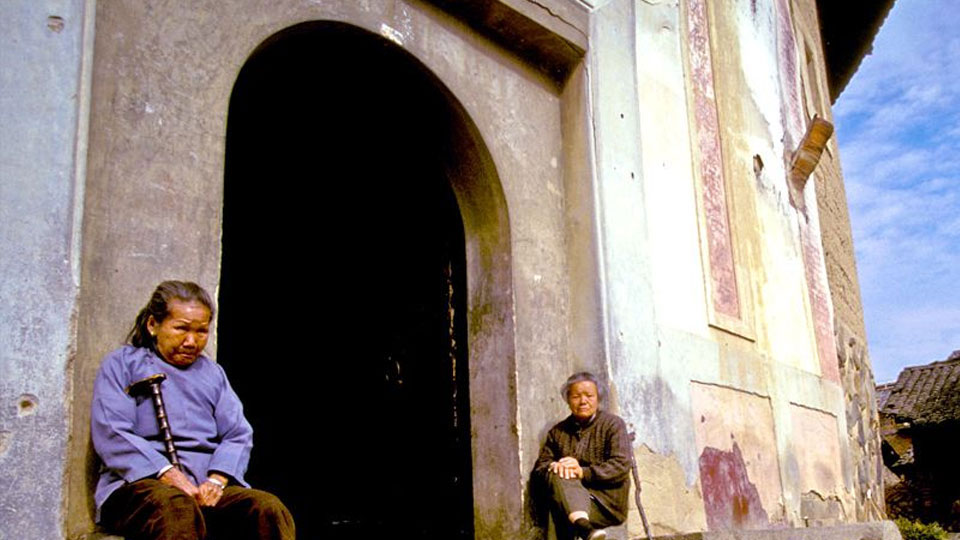

ADB is working with the People’s Republic of China to pilot public-private partnership in elderly care.
How to deal with the elderly is a pressing challenge for the People’s Republic of China with the number of the over 65s set to rise from 142 million in 2016 to 289 million, or 20% of the population, by 2034.
In the People’s Republic of China, ADB is working with the local government in Yichang, a third-tier city in the Yangtze River Economic Belt region, to structure a public-private partnership that will demonstrate how the government and private entities can work together to provide better elderly care services.
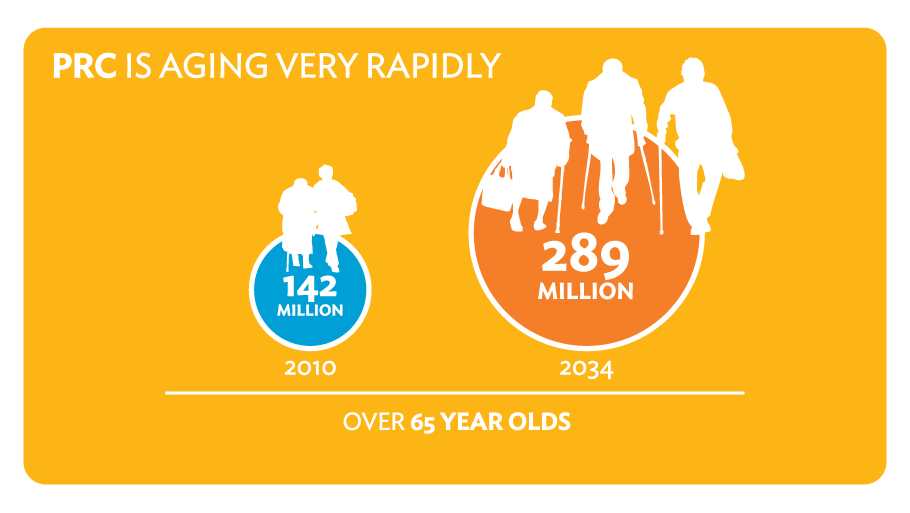
Li Zheng and his wife thought that his son and daughter-in-law would look after them when they got old but since they moved away, they will have to make other arrangements.
“When I reach the age when I have physical difficulties, I will definitely want to go to an old-age residential home,” said the 84-year-old Mr. Li, a retired engineer now living in central Beijing, in the People’s Republic of China (PRC). “I think a good elderly care system should include good surroundings, good facilities for entertainment, and good food, as well as easy access to hospital and healthcare.”
“Private sector technical and operational expertise as well as possible funding will be crucial to tackling the complexities of elderly care” Hiroko Uchimura Shiroishi, Senior Social Sector Specialist, East Asia Department.
The decisions facing Mr. Li and his wife are typical in the PRC which has seen the number of its elderly soar in recent decades even as their children, who in the past would have looked after them, are moving away in search of jobs.
How to deal with the elderly is a pressing challenge for the PRC too with the number of the over 65s set to rise from 142 million in 2016 to 289 million, or 20% of the population, by 2034 (ADB Briefs, 2018). The country will have some 98 million people aged 80 years or more by then too, up from just 18 million now (ADB Project). However, other countries in the region will also need to address this issue sooner or later.
By 2018, for example, 11.9% of Thailand’s population was aged 65 years or more, up from 6.5% in 2000, but even countries still enjoying a demographic dividend such as India, the elderly now makes up a larger 6.2% of the population and 5.9% in Indonesia (Key Indicators).
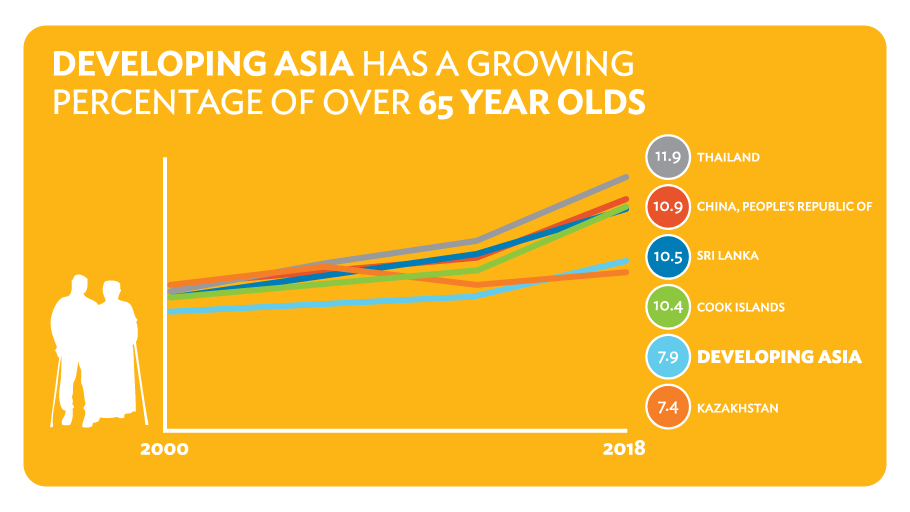
“Economies will slow if the region doesn’t deal with its greying population. Asia is unique in that it is aging much faster than other regions and so it needs new solutions specific to the region,” said Donghyun Park, Principal Economist with the Asian Development Bank’s (ADB) Economic Research and Regional Cooperation Department.
Governments though face numerous calls on their finances and have little experience providing elderly care. Needs can vary with some cities aging more rapidly than others. Some elderly need intensive care to tackle dementia or physical disabilities while others may need only intermittent care at home. Elderly care also needs to be coordinated with overall healthcare.
“Private sector technical and operational expertise, as well as possible funding, will be crucial to tackling this,” said Hiroko Uchimura Shiroishi, Senior Social Sector Specialist with ADB’s East Asia Department, noting that while spending on elderly care is going up, it isn’t rising as fast as it needs to. In Asia, government assistance to the elderly in the form of noncontributory transfers or social pensions averages only 0.2% of aggregate gross domestic product, with only five countries – the Maldives, the Republic of Korea, Thailand, Mongolia, and Nepal – spending more than that (Social Protection Index).
In the PRC, ADB is working with the local government in Yichang, a third-tier city in the Yangtze River Economic Belt region, to structure a public-private partnership (PPP) that will demonstrate how the government and private entities can work together to provide better elderly care services. Under the PPP, the Yichang local government will build the elderly care facilities while the private entity will run them, providing different levels of care. An upcoming project in the southern Guangxi Zhuang Autonomous Region will build on this work to train and develop another PPP project in which the private sector partner will both build and run the elderly facilities and services.
Another PPP project in the pipeline in Xiangyang, Hubei Province will further help develop a range of care services, including residential care, daycare, rehabilitation, and geriatric medicine.
“Across developing Asia, there is a huge lack of knowledge within local governments about the intricacies of social sector PPP design, procurement, and contract management,” said Srinivas Sampath, Chief of ADB’s PPP thematic group. “Promoting a mechanism for genuine and transparent PPPs that can be replicated would allow the region to tackle the funding gap and the complex issues around elderly care.”
Services will focus around a three-tier system comprising options for elderly care in elderly residences, in the community, or from their home rather than simply building more old-age homes with more beds. This 3-pronged approach is in line with international trends which recognizes that delivering services to the elderly in their own home is both better for the older person, more cost-effective in the long-run, and allows family carers to return to the labor market.
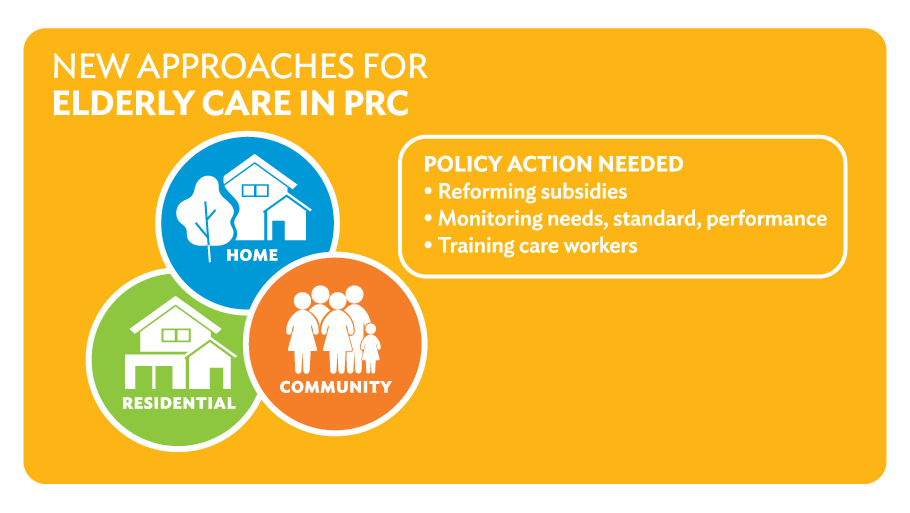
And the projects will also help improve training for the large numbers of caregivers, nurses, physiotherapists, and others needed to ensure the elderly stay fit and healthy as long as possible.
This article is reproduced from Asian Development Bank.
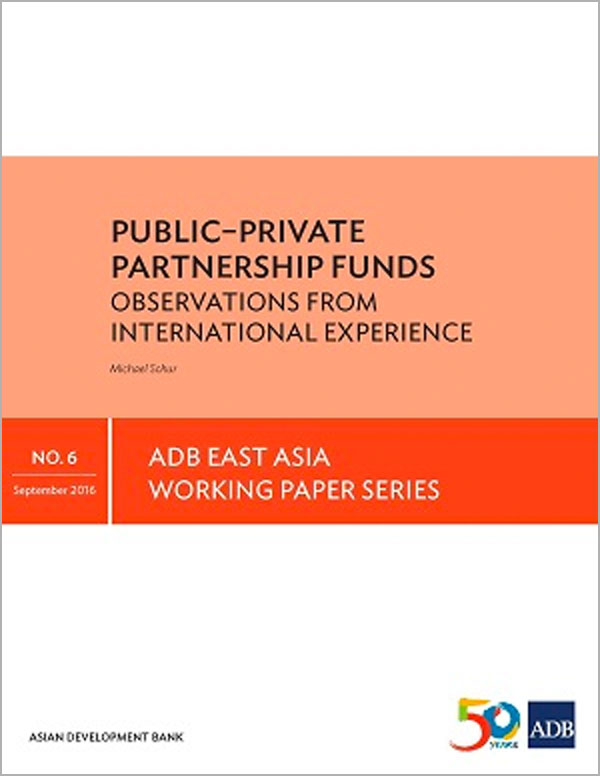
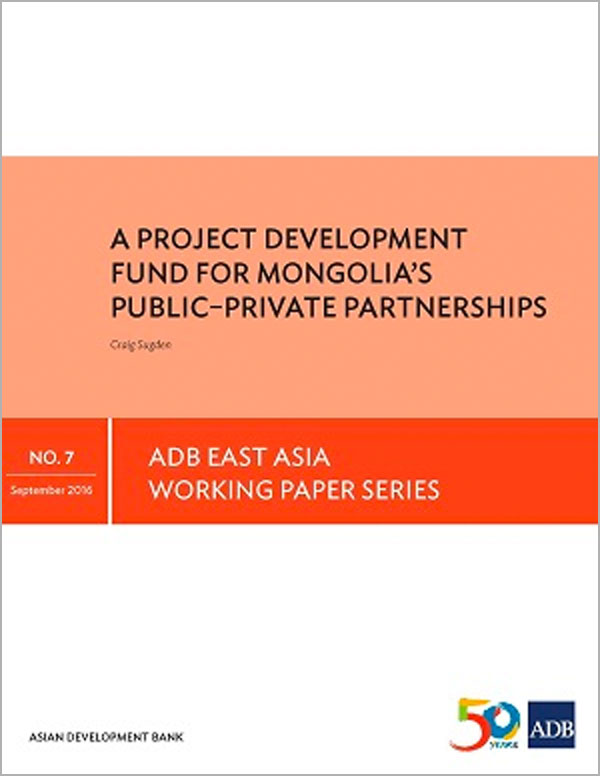
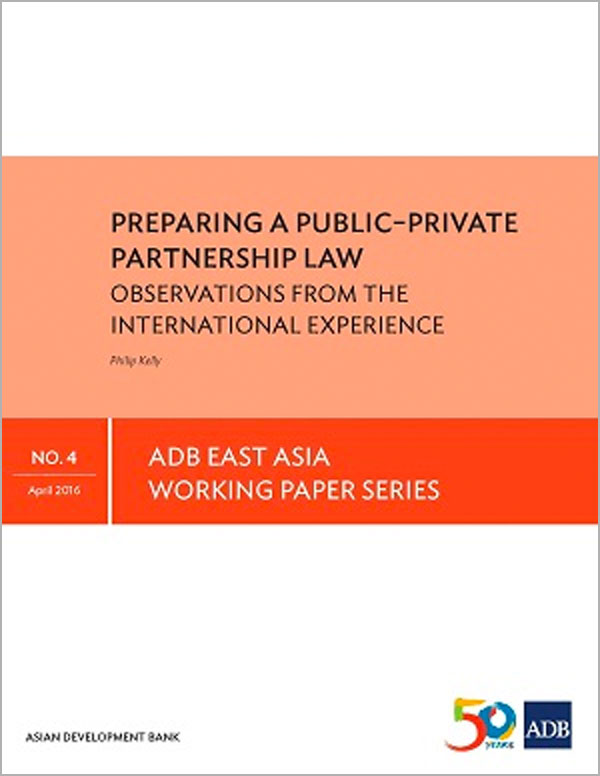
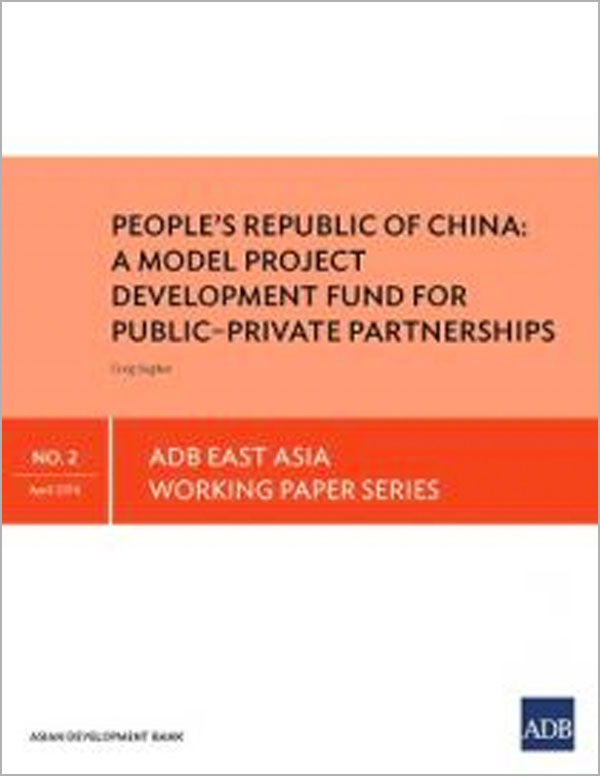
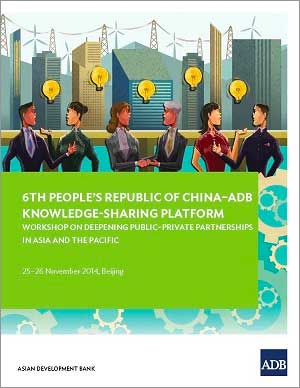
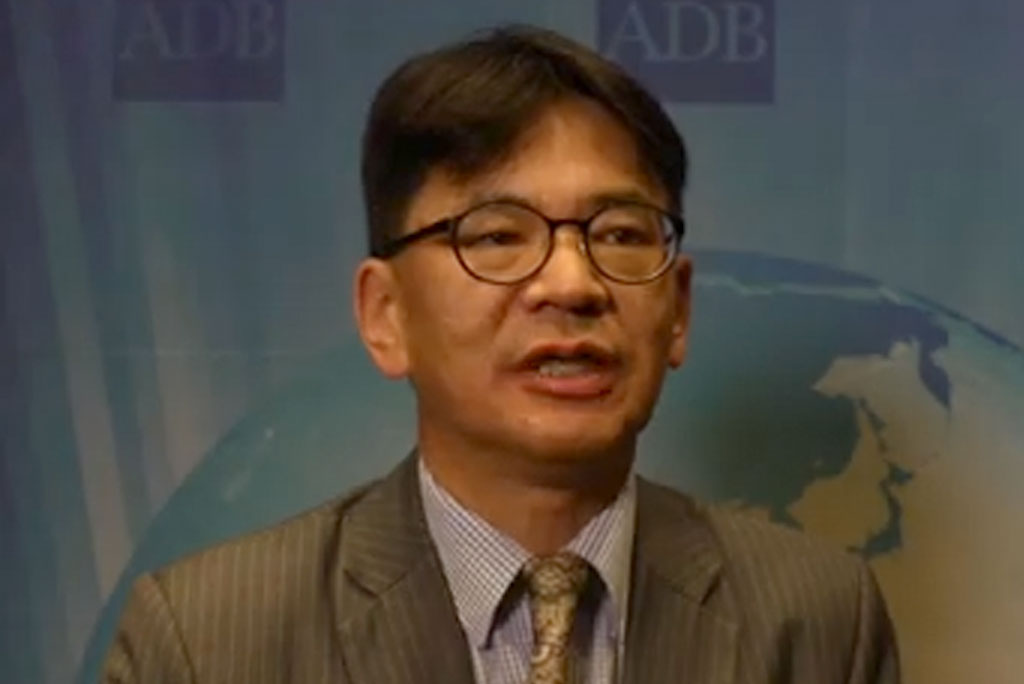
6th PRC-ADB Knowledge Sharing Platform: Deepening Public-Private Partnerships
Bekhbat Sodnom, Department of Innovation and PPP Ministry of Economic Development, Mongolia, shares the country’s policies and legal framework on PPP.
© 2025 Regional Knowledge Sharing Initiative. The views expressed on this website are those of the authors and presenters and do not necessarily reflect the views and policies of the Asian Development Bank (ADB), its Board of Governors, or the governments they represent. ADB does not guarantee the accuracy of the data in any documents and materials posted on this website and accepts no responsibility for any consequence of their use. By making any designation of or reference to a particular territory or geographic area, or by using the term “country” in any documents posted on this website, ADB does not intend to make any judgments as to the legal or other status of any territory or area.
